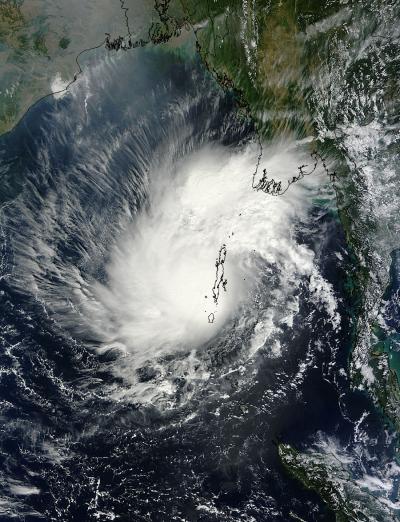The Andaman Islands received an unwelcome visitor on November 25 in the form of Tropical Cyclone Lehar. NASA's Terra satellite captured a picture of the visitor as it was making its exit from the islands and into the Bay of Bengal.
Tropical Depression 05B formed off the west coast of the Malay Peninsula on November 23 and strengthened into Tropical Cyclone Lehar as it moved from the Andaman Sea over the Andaman Islands and is now working its way into the Bay of Bengal and toward India. The Andaman Islands are located in the eastern Bay of Bengal. Burma lies north and east of the island group and India lies to the west.
Tropical Cyclone Lehar was over the Andaman and Nicobar Islands at the time NASA's Terra satellite flew overhead and captured a visible image of the storm. On November 25, 2013 at 04:25 UTC/Nov. 24 11:25 p.m. EST, the Moderate Resolution Imaging Spectroradiometer or MODIS instrument that flies aboard Terra took a picture of the tropical cyclone as the eastern side of the storm covered the island. Most of Cyclone Lehar was west of the island in the Bay of Bengal, although the northeastern edge of the storm extended over west-central Burma, bringing clouds to Yangon, capital city of the Yangon region. By November 26, Lehar was bringing rainfall and gusty winds to the region.

On Nov. 25, 2013 at 04:25 UTC/Nov. 24 11:25 p.m. EST, NASA's Terra took a picture of the tropical cyclone as the eastern side of the storm covered the island.
(Photo Credit: Image : NASA Goddard MODIS Rapid Response Team)
At 1500 UTC/10 a.m. EST on November 25, Tropical Cyclone Lehar had maximum sustained winds near 65 knots/74.8 mph/120.4 kph, achieving hurricane-force. It was centered near 12.6 north and 90.6 east, about 550 nautical miles/633 miles/1,019 km southeast of Visakhapatnam, India. Lehar is moving away from Burma and toward the west-northwest at 7 knots/8 mph/12.9 kph. Lehar is generating 20-foot/6.0 meter high seas
Forecasters at the Joint Typhoon Warning Center expect that warm water temperatures and low wind shear will assist Lehar in intensifying as it moves in a west-northwesterly direction across the Bay of Bengal. Forecasters expect maximum sustained winds to peak near 100 knots/115.1 mph/185.2 kph before making landfall in eastern India.
As a result warnings are already in effect for India. Lehar's winds area expected to affect Northern Andhra Pradesh and southern Odisha by Wednesday, November 27.
Source: NASA/Goddard Space Flight Center